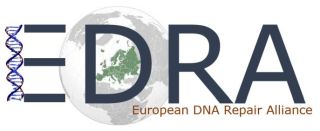|
|
|
Previous webinars > 8th seminar, 05/30/20238th webinar, May 30th 2023, 3.30 to 5 pm CET Zoom link for today's event: Keynote presentation by Dr Gaelle Legube CBI LBCMCP CNRS UMR5088, University of Toulouse, Toulouse, France Chromosome and chromatin dynamics at DNA Double Strand Breaks DNA double-strand breaks (DSBs) are highly toxic lesions that are rapidly repaired by two main pathways, namely Homologous Recombination (HR) and Non Homologous End Joining (NHEJ). Using a cell line, called DIvA (for DSB Inducible via AsiSI), where multiples breaks are induced at annotated positions, combined with genome-wide, high throughput sequencing based techniques (ChIP-seq, HiC...) we investigate the contribution of chromatin and chromosome conformation in the response to DSB. I will present our recent work, on the contribution of chromatin and Topologically Associating Domains (TADs) during DSB repair. More specifically we recently demonstrated the role of cohesin-mediated loop extrusion in establishing gH2AX on an entire TAD in cis to DSBs. We now provide evidence that when established, gH2AX “tagged” TAD further self-segregate in the nucleus, forming a novel DSB-induced chromatin compartment (the “D” compartment) that contributes to the activation of the DNA damage response. This project has received funding from the European Research Council (ERC) under the European Union’s Horizon 2020 research and innovation programme (grant agreement No 647344 and grant agreement No 101019963) The keynote presentation will be followed by two 15 min short talks: Hervé Techer, Institut de Génétique Humaine (IGH) CNRS Université de Montpellier MRE11 and TREX1 nucleases control RASv12 oncogene-induced senescence Oncogene-induced senescence is a particular state in which cells stop proliferating in response to oncogenic stress. It has been shown recently that senescence depends on the cGAS (cyclic GMP-AMP Synthase) and STING (Stimulator of Interferon Genes) pathway that detects cytosolic DNA and promotes the expression of inflammatory cytokines. Although these results suggest that cytosolic DNA promotes senescence, the molecular mechanism by which inflammatory response connects to the classical DNA damage response remains unclear. We show that senescence and micronuclei formation are both abrogated by inhibition of MRE11 nuclease activity in human fibroblasts overexpressing the RASV12 oncogene. Moreover, either overexpression of the 3'-exonuclease TREX1 or inhibition of cGAS blocks RASV12 induced-senescence. Expression of the dominant-negative TREX1(D18N) promotes genomic instability and induces senescence in human fibroblasts. Altogether, our results suggest that MRE11 and TREX1 nucleases regulate senescence through the modulation of cytosolic DNA levels, production of Type I interferon response and control of genome stability. This observation highlights how the interplay between the replication stress response and inflammatory signaling affects cell fate, paving the way for the comprehension of age-related diseases. Camille Gelot, Institut Curie, PSL Research University Polθ is phosphorylated by Polo-like kinase 1 (PLK1) to enable repair of DNA double strand breaks in mitosis DNA double strand breaks (DSBs) are deleterious lesions that challenge genome integrity. To mitigate this threat, human cells rely on the activity of multiple DNA repair machineries that are tightly regulated throughout the cell cycle. In interphase, DSBs are mainly repaired by non-homologous end joining (NHEJ) and homologous recombination (HR). However, these pathways are completely inhibited in mitosis, leaving the fate of mitotic DSBs unknown. Here we show that DNA polymerase theta (Polθ) repairs mitotic DSBs and thereby maintains genome integrity. In contrast to other DSB repair factors, Polθ function is activated in mitosis upon phosphorylation by the Polo-like kinase 1 (PLK1). Phosphorylated Polθ is recruited to mitotic DSBs, where it mediates joining of broken DNA ends, while halting mitotic progression. The lack of Polθ leads to a shortening of mitotic duration and defective repair of mitotic DSBs, resulting in a loss of genome integrity. In addition, we identify mitotic Polθ repair as the underlying cause of the synthetic lethality between Polθ and HR. Our findings reveal the critical importance of mitotic DSB repair for maintaining genome stability.
|



